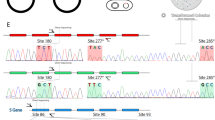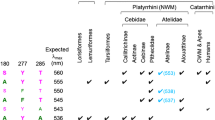Abstract
Albinism is a rare phenotype that affects the pigmentation in eyes, hair, and skin. The effects of albinism in color vision are still unclear. Our study aimed to evaluate the color vision phenotype and genotype of an albino capuchin monkey. An adult albino male capuchin monkey (Sapajus apella) had the L and M opsin gene analyzed, and was trained in a behavioral task of color discrimination. Color discrimination thresholds were determined along 20 chromatic axes around the background chromaticity. A color discrimination ellipse was drawn by interpolation among these thresholds. The albino monkey’s behavioral color discrimination ellipse showed poor discrimination along the red–green axis indicating a deutan phenotype. Genetic analysis revealed only the presence of the L gene in the albino monkey. This result did not differ from that obtained with ten previously tested non-albino monkeys. Behavioral and molecular analyses agreed that the albino capuchin monkey had color vision similar to that of non-albino dichromat monkeys, suggesting no influence of albinism on color discrimination.





Similar content being viewed by others
References
Altavini TS, Henriques LD, Bonci DMO, Nagy BV, Ventura DF, Pessoa VF (2012) Using the Hard, Randy, and Rittler test to evaluate color vision in capuchins (Cebus libidinosus). Int J Primatol 33:1467–1476. https://doi.org/10.1007/s10764-012-9638-8
Asenjo AB, Rim J, Oprian DD (1994) Molecular determinants of human red/green color discrimination. Neuron 12:1131–1138
Forrest SC, Naveen R (2000) Prevalence of leucism in pygocelid penguins of the Antarctic peninsula. Waterbirds 23(2):283–285
Goulart PRK, Bandeira ML, Tsubota D, Oiwa NN, Costa MF, Ventura DF (2008) A computer-controlled color vision test for children based on the Cambridge Colour Test. Vis Neurosci 25:445–450. https://doi.org/10.1017/S0952523808080589
Goulart PRK, Bonci DMO, de Galvão OF, Silveira LCL, Ventura DF (2013) Color discrimination in the tufted capuchin monkey, Sapajus spp. PLoS ONE 8:4–12. https://doi.org/10.1371/journal.pone.0062255
Govardovskii VI, Fyhrquist N, Reuter T, Kuzmin DG, Donner K (2000) In search of the visual pigment template. Vis Neurosci 17:509–528. https://doi.org/10.1017/S0952523800174036
Grønskov K, Ek J, Brondum-Nielsen K (2007) Oculocutaneous albinism. Orphanet J Rare Dis 2:1–8. https://doi.org/10.1186/1750-1172-2-43
Guillery RW, Hickey TL, Kaas JH, Felleman DJ, Debruyn EJ, Sparks DL (1984) Abnormal central visual pathways in the brain of an albino green monkey (Cercopithecus aethiops). J Comp Neurol 226:165–183. https://doi.org/10.1002/cne.902260203
Hoffmann MB, Tolhurst DJ, Moore AT, Morland AB (2003) Organization of the visual cortex in human albinism. J Neurosci 23:8921–8930
Jacobs GH (1996) Primate photopigments and primate color vision. Proc Natl Acad Sci USA 93:577–581
Jacobs GH, Deegan JF (2005) Polymorphic New World monkeys with more than three M/L cone types. J Opt Soc Am A Opt Image Sci Vis 22:2072
Kamaraj B, Purohit R (2014) Mutational analysis of oculocutaneous albinism: a compact review. Biomed Res Int 2014:905472. https://doi.org/10.1155/2014/905472
Khachiyan LG (1980) Polynomial algorithm in linear programming. USSR Comput Math Math Phys 20:53–72. https://doi.org/10.1016/0041-5553(80)90061-0
Mancuso K, Neitz M, Neitz J (2006) An adaptation of the Cambridge Colour Test for use with animals. Vis Neurosci 23:695–701. https://doi.org/10.1017/S0952523806233364
McCardle H (2012) Albinism in wild vertebrates. Texas State University, San Marcos
Mollon JD, Regan BC (2000) Cambridge colour test handbook. Cambridge Research System, London
Neitz M, Neitz J, Jacobs GH (1991) Spectral tuning of pigments underlying red–green color vision. Science 252:971–974
Paramei GV (2012) Color discrimination across four life decades assessed by the Cambridge Colour Test. J Opt Soc Am A 29:A290. https://doi.org/10.1364/JOSAA.29.00A290
Sano RY (2017) Avaliação oftalmológica e psicofísica do sistema visual de indivíduos com albinismo. Universidade de São Paulo, São Paulo
Soares JGM, Fiorani M, Araujo EA, Zana Y, Bonci DMO, Neitz M, Ventura DF, Gattass R (2010) Cone photopigment variations in Cebus apella monkeys evidenced by electroretinogram measurements and genetic analysis. Vision Res 50:99–106. https://doi.org/10.1016/j.visres.2009.10.017
Summers GC (1996) Vision in albinism. Trans Am Ophthalmol Soc 94:1095–1155
Vasconcelos FT, Hauzman E, Henriques LD, Goulart PRK, Galvão OF, Sano RY, Souza GS, Alfaro JL, Silveira LCL, Ventura DF, Bonci DMO (2017) A novel nonsense mutation in the tyrosinase gene is related to the albinism in a capuchin monkey (Sapajus apella). BMC Genet 18:39. https://doi.org/10.1186/s12863-017-0504-8
Acknowledgements
We thank the support of our friends and coworkers of the Labvis and EEP on scientific brainstorming and animal care. We also thank Maria de Nazaré Nascimento for veterinary assistance and Adilson Pastana for monkey management. This work was supported by the Conselho Nacional de Desenvolvimento Científico e Tecnológico (CNPq 448228/2011-0 to OFG) and by the Fundação de Amparo à Pesquisa do Estado de São Paulo—FAPESP (Master's Fellowship to LDH 2011/05059-8 and Projeto Temático 2014/26818-2 to DFV). Author DFV is a 1 A CNPq Productivity Fellow 309409/2015-2).
Funding
This work was supported by the Conselho Nacional de Desenvolvimento Científico e Tecnológico (CNPq 448228/2011-0 to DFV, 573972/2008-7 to OFG and Chamada Universal 01/2016—Faixa A, P427827/2016-7 to PRKG), by CNPq Productivity Fellowships to DFV (309409/2015-2), OFG (P309475/2018-0) and GSS (310845/2018-1), by the Fundação de Amparo à Pesquisa do Estado de São Paulo (Master Schoolarship 2011/05059-8 to LDH, Thematic Project 2014/26818-2 to DFV, 2008/57705-8, and by the National Institute of Science and Technology project on Behavior, Cognition and Education).
Author information
Authors and Affiliations
Contributions
HLD: experiment conception, data collection, data analysis, article drafting, and article revisioning. OJCP: data collection and article revisioning. BDMO: data analysis and article revisioning. LRC: data collection and article revisioning. SGS: data analysis and article revisioning. SLCL: experiment conception and data analysis. GOF: experiment conception, data analysis, and article revisioning. GPRK: experiment conception, data collection, data analysis, and article revisioning. VDF: experiment conception, data analysis, and article revisioning.
Corresponding author
Ethics declarations
Conflict of interest
The authors declare that they have no conflict of interest.
Ethical approval
All applicable international, national, and/or institutional guidelines for the care and use of animals were followed. All procedures performed in studies involving animals were in accordance with the ethical standards of the institution or practice at which the studies were conducted (Ethics Committee for Animal Research from Federal University of Pará—CEPAE-UFPA PS014/2015).
Additional information
Publisher's Note
Springer Nature remains neutral with regard to jurisdictional claims in published maps and institutional affiliations.
Rights and permissions
About this article
Cite this article
Henriques, L.D., Oliveira, J.C.P., Bonci, D.M.O. et al. Behavioral and genetic color vision evaluation of an albino male capuchin monkey (Sapajus apella). J Comp Physiol A 205, 529–536 (2019). https://doi.org/10.1007/s00359-019-01342-4
Received:
Revised:
Accepted:
Published:
Issue Date:
DOI: https://doi.org/10.1007/s00359-019-01342-4




